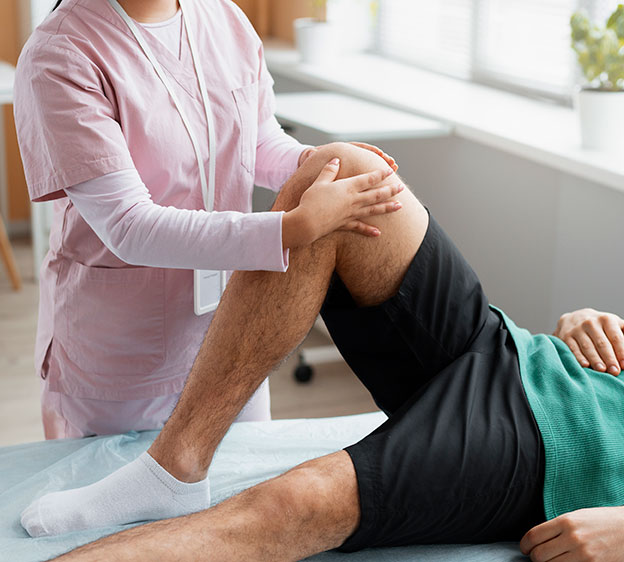
First comes a pop and then comes the pain. That’s a common progression of meniscus tear symptoms, which occur following an injury to one of the crescents of the protective cartilage that sit on each side of your knee.
“For many of the patients I see with meniscus tears, the first clue something is wrong is when they feel a pop in their knee,” says board-certified orthopedic surgeon Dr. Vandit Sardana. “In the ensuing hours and days, the joint often becomes painful and swollen. Putting weight on the knee may be difficult. Those are signs you should see your primary care provider or an orthopedic specialist to find out what’s going on.”
Read More: What Causes Knee Pain Going Down Stairs?
Symptom Sources: How Meniscus Tears Occur
On each side of your kneecap, a meniscus sits between the base of the thigh bone and the top of the shinbone, preventing them from rubbing together when you walk. Each meniscus acts as a shock absorber and stabilizer for the knee.
One of the most common knee injuries, meniscus tears — sometimes called meniscal tears — can occur due to a sudden injury or from wearing out over time.
“If you play sports, you have a higher risk for acute meniscus tears,” says Dr. Sardana, who sees patients at Beaufort Memorial Orthopaedic Specialists in Beaufort and Okatie. “You may injure the cartilage if, for example, you twist your knee when landing after heading a soccer ball or if you suddenly stop and change direction while running during football practice. In these situations, you can also injure knee ligaments at the same time. Sports medicine specialists are skilled at treating acute meniscus injuries.”
As you get older, the meniscus loses some of its elasticity and becomes more vulnerable to tears. In older adults, meniscus injuries can occur from twisting or bending the knee during daily activities, such as kneeling to pick up an object or bending to stand up from a chair.
Read More: Head Off Sports Injuries Before They Happen
How to Recognize Meniscus Tear Symptoms
Several signs may point to a problem with your knee’s crucial cartilage. Whether you feel a pop in the joint or not, look for common symptoms of a meniscus tear, including:
- Difficulty crouching
- Feeling like your knee won’t support you
- Knee locking
- Pain that increases when you put pressure on your knee
- Pain when walking
- Reduced range of motion in the affected knee
- Swelling and stiffness that worsens within three days after the injury
Read More: ACL vs. MCL Tears
Pinpointing the Problem
To diagnose a meniscus tear, your health care provider will ask about your medical history, how the injury occurred and your symptoms. They’ll gently move their fingers along each side of your kneecap to see if the area is tender, which could indicate a tear. They may also ask you to bend, straighten and rotate your knee, which may prompt meniscus tear symptoms, such as discomfort or clicking of the joint.
“Medical imaging is usually a key part of the diagnostic process,” Dr. Sardana says. “X-rays can help us rule out other potential causes of your symptoms. An MRI can allow us to look for tears in the meniscus and check for damage or disease in a surrounding ligament.”
Finding Relief: Treatment Options for Meniscus Injuries
In many cases, nonsurgical treatment may be enough to heal a meniscus tear, especially if the injury affects the outer portion of the cartilage. This area has a robust blood supply that helps support healing, according to the American Academy of Orthopaedic Surgeons. Further inside the meniscus, however, the blood supply isn’t as strong, so tears to this region may be more likely to require surgery.
Nonsurgical treatment for a meniscus tear may include:
- Attending physical therapy to learn strengthening exercises
- Following the RICE treatment program of rest, ice, compression and elevation
- Taking nonsteroidal anti-inflammatory medications or getting a steroid injection to relieve pain and swelling
- Wearing a brace or using crutches
“In most cases, we want to try every nonsurgical treatment option before considering surgery,” Dr. Sardana notes. “If surgery is appropriate, you’ll likely have an arthroscopic procedure. The surgeon will place a camera through a small incision to see the meniscus tear. Then, they’ll make a few more tiny incisions and, through them, use surgical instruments to repair the injury or remove damaged cartilage.”
Read More: The 411 on Knee Braces
Can You Stop Meniscus Tear Symptoms Before They Start?
Preventing meniscus tears isn’t always possible. For athletes of all abilities, though, a smart approach to playing sports can reduce the risk of injury.
“Protecting the muscles around your knee helps safeguard the joint itself, including the meniscus,” says Dr. Sardana. “You can maintain healthy, supportive muscles by strengthening them with regular exercise that includes warm-up and cool-down sessions. No matter what sport you play, be sure to wear shoes that are appropriate for that sport. In addition, learn the proper ways to jump, land and change direction when you run.”
Dealing with knee pain, swelling or a reduced range of motion? Request an appointment with an orthopedic specialist who can identify the cause of your symptoms and recommend the treatment that makes the most sense for you.

